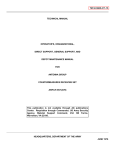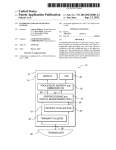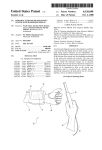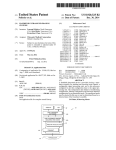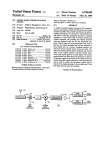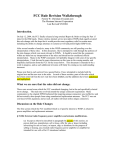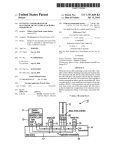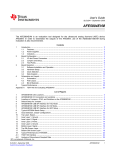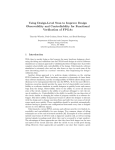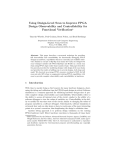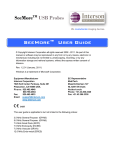Download [>q SCAN
Transcript
US005 8 17024A Ulllted States Patent [19] [11] Patent Number: Ogle et al. [45] [54] Date of Patent: Oct. 6, 1998 HAND HELD ULTRASONIC DIAGNOSTIC 5,123,415 6/1992 Daigle .............................. .. 128/661.01 INSTRUMENT WITH DIGITAL 5,295,485 3/1994 Shinomura et a1. BEAMFORMER 5,360,005 11/1994 5,369,624 11/1994 Fukukita et a1. Inventors: Botheu; Greisel, Justin Seattle; I‘I Ogle, coughlin, Blake W- Seattle; Larry Little, , , / Steven G. Danielson, Seattle; Lauren _ ‘i . . . . .. 128/6531 ....... .. 600/447 ghianglettall. rieme Ct e 8.1. a. ................... ........................ ....................... .. .. / _ _ _ _ 1979) Ultra PCI System Speci?cations from Advanced Medical Products of Columbia, South Carolina (date unknown). Appl NO _ 863 937 ' 128/66007 ... ... .... ... ... ... M1n1v1s0r Service Manual from Organon Teknlka (Sep. [73] Assignee: SOnOSight, Inc., Bothell, Wash. [22] Filed: Wilk OTHER PUBLICATIONS S. P?ugrath, Seattle, all of Wash. [21] 5,817,024 ’ “Micros Q.V.” brochure by Advanced Medical Products, May 27, 1997 Inc. (Sep. 1996). Related US, Application Data Primary Examiner—George Manuel Attorney, Agent, or Firm—W. Brinton Yorks, Jr. 63 [ 1 51 Continuation-in- art of Ser. No. 672,782, Jun. 28, 1996, Pat. NO. 5,222,412. P [57] ABSTRACT Int. Cl.6 ...................................................... .. A61B 8/00 A hand held ultrasonic instrument is P rovided in a P ortable [52] ________ __ 600/447 unit Which performs both B mode and Doppler imaging. The [58] Field of Search ................................... .. 600/444, 445, instrument includes a transducer array mounted in a hand‘ 600/446, 447, 459; 73/625, 626, 628, 633, 640, 641, 642 held enclosure, With an integrated circuit transceiver con nected to the elements of the array for the reception of echo signals. A digital beamformer is located in the hand-held enclosure for forming ultrasonic scanlines from the echo signals received by the elements of the array. [56] References Cited U.S. PATENT DOCUMENTS 4,173,007 10/1979 McKeighen et a1. ................... .. 367/11 28 Claims, 15 Drawing Sheets 30 T/R ASIC / [><] FE ASIC [>q l>q D4 40 50 / / DSP ASIC BE ASIC SYNTHETIC APERTURE DAG ADC DELAY- SUM 8X TIME DATE SCAN FREQUENCY —> CONVERSION COMPOUNDING 502 TRANSMIT & COLOR POWER TIMING CONTROL ANGIO GRAPHICS RISC PROCESSOR VIDEO | l 10 / | I 20 3D CPA MEMORY MEMORY / 42 PROGRAM VIDEO MEMORY MEMORY 70 / 32 52 80 \ POWER SUB SYSTEM BATTERY MANAGEMENT O O O USER CONTROL 0 O E%j so 54 55 PCMCIA INTERFACE LCD D'SPLAY U.S. Patent 0a. 6, 1998 Sheet 1 0f 15 cm .GEF 2 5,817,024 U.S. Patent 0a. 6, 1998 Sheet 2 0f 15 5,817,024 wm 8/ #\mmi.l| E U.S. Patent 0a. 6, 1998 Sheet 3 0f 15 5,817,024 .GEw “HF-NIH .GEQM .GEmm. wm U.S. Patent 0a. 6, 1998 Sheet 5 0f 15 5,817,024 vwA3mj0m .5X63z0_m6w l1\me U.S. Patent 0a. 6, 1998 500 Sheet 6 0f 15 5,817,024 FIG. 7 r \ 16/8 CHANNEL BEAMFORMER \ J 424426 20A 446 20B 20C 20D 20E 20F 20G 20H U.S. Patent 0a. 6, 1998 F9aIG. Sheet 9 0f 15 5,817,024 U.S. Patent Oct.6,1998 0k- _wmm “Evmm .GE2 Sheet 10 0f 15 92_ 5,817,024 m1 59%.: EOE" OmEmt_w< a Ntwo+ own NIEZ<O U.S. Patent Oct.6,1998 Sheet 12 0f 15 5,817,024 U.S. Patent Oct.6,1998 Sheet 13 0f 15 5,817,024 FIG. 13 0 >T|ME SEGMENT FIG. 14 WEIGHT M 181 \ 0 '\ 180 >SAMPLE W 183 COUNT U.S. Patent .GE F m Oct.6,1998 Sheet 14 0f 15 5,817,024 U.S. Patent Oct. 6, 1998 Sheet 15 0f 15 5,817,024 FIG. 16 SWITCH FUNCTION POWER OFF/ON DESCRIPTION O NUMBER OF CONTACTS SLIDE SWITCH 1 ACTIvE SCAN/FREEZE O PUSH AND HOLD FOR ACTIvE SCAN 1 CPA DOPPLER/CPA FILTER ANGIO CPA HIGH/MEDIUM/LOW BUTTON CYCLES ENABLES AND DISABLES COLOR POWER 1 O O THROUGH 3 SELECTIONS ENABLES 3D CAPTURE WHEN ENGAGED 3D IMAGING MODE 9 BEFORE THE ACTIVE SCAN BUTTON IS PUSHED PRINT @ SENDS SERIAL SIGNAL TO PRINTER 1 1 1 6 CURSOR POSITION IO OI X/Y POSITION OF CURSOR 4 ENTERS SELECTION 1 _Q_ ENTER (3 MENU 0 MEASURE O FOCUS O TOGGLES MENU FUNCTIONS OFF AND ON, USES CURSOR AND ENTER. FUNCTIONS: APPLICATION SELECTION USED TO ENTER 1 ALPHA NUMERIC DATA, PATIENT ID, PATIENT NAME, CINE 2D AND 3D REvIEW ENABLES MEASUREMENTS, USES CURSOR AND ENTER 1 ENABLES FOCUS MODE, CURSOR UP DOWN POSITIONS FOCUS, CURSOR LEFT RIGHT SELECTS NUMBER OF ZONES ALLOWS THE USER TO SELECT THROUGH SEvERAL GRAY SCALE CURVES, SPATIAL AND TEMPORAL FILTERS WITHIN A PREDETERMINED SET OF SETUPS FOR A SELECTED APPLICATION |MAGE 1 2 DEPTH @ UP/DOWN, 5 DEPTH SELECTIONS 2 TGC GAIN ® UP/DOWN 2 BRIGHTNESS @ LCD DISPLAY CONTROL UP/DOWN 2 CONTRAST @ LCD DISPLAY CONTROL UP/DOWN 2 5,817,024 1 2 HAND HELD ULTRASONIC DIAGNOSTIC INSTRUMENT WITH DIGITAL BEAMFORMER on a single printed circuit board, eliminating the problems conventionally posed by connectors and cables. This sophis ticated ultrasound instrument can be manufactured as a hand held unit Weighing less than ?ve pounds. In the draWings: This is a continuation-in-part of US. patent application FIG. 1 illustrates in block diagram form the architecture of a hand-held ultrasound system of the present invention; Ser. No. 08/672,782, ?led Jun. 28, 1996 now US. Pat. No. 5,722,412. This invention Was made With government support under agreement no. N00014-96-2-0002 awarded by the Of?ce of Naval Research. The government has certain rights in the invention. This invention relates to medical ultrasonic diagnostic systems and, in particular, to a fully integrated hand held ultrasonic diagnostic instrument. As is Well knoWn, modern ultrasonic diagnostic systems are large, complex instruments. Today’s premium ultra FIGS. 2a and 2b are front and side vieWs of a hand-held 10 FIGS. 3a and 3b are front and side vieWs of the trans ducer unit of a tWo-unit hand-held ultrasound system of the present invention; FIG. 4 illustrates the tWo units of a hand-held ultrasound 15 sound systems, While mounted in carts for portability, con tinue to Weigh several hundred pounds. In the past, ultra sound systems such as the ADR 4000 ultrasound system produced by Advanced Technology Laboratories, Inc., 20 assignee of the present invention, Were smaller, desktop units about the siZe of a personal computer. HoWever, such instruments lacked many of the advanced features of today’s premium ultrasound systems such as color Doppler imaging and three dimensional display capabilities. As ultrasound systems have become more sophisticated they have also 25 become bulkier. HoWever, With the ever increasing density of digital electronics, it is noW possible to foresee a time When ultrasound systems Will be able to be miniaturiZed to a siZe even smaller than their much earlier ancestors. The physi cian is accustomed to Working With a hand held ultrasonic scanhead Which is about the siZe of an electric raZor. It 30 system of the present invention in a tWo-unit package; FIG. 5 is a schematic diagram of the transmit/receive ASIC of the ultrasound system of FIG. 1; FIG. 6 is a block diagram of the front end ASIC of the ultrasound system of FIG. 1; FIG. 7 illustrates the aperture control afforded by the transmit/receive and front end ASICs; FIG. 8 is a block diagram of the frame and RF header sequencers of the front end ASIC of FIG. 6; FIG. 9 is a block diagram of the line, TGC, serial bus and address sequencers of the front end ASIC of FIG. 6; FIG. 10 is a block diagram of the summing netWork for the beamformer channels of the front end ASIC of FIG. 6; FIG. 11 is a block diagram of one of the dynamic focus controllers of the front end ASIC of FIG. 6; FIG. 12 is a block diagram of one of the dynamic Weight controllers of the front end ASIC of FIG. 6; FIG. 13 is an exemplary focus control curve used to explain the dynamic focus controller of FIG. 11; FIG. 14 is an exemplary Weighting function curve used Would be desirable, consistent With the familiar scanhead, to be able to compact the entire ultrasound system into a scanhead-siZed unit. It Would be further desirable for such an ultrasound instrument to retain as many of the features of ultrasound system of the present invention Which is pack aged as a single unit; 35 to explain the dynamic Weight controller of FIG. 12; FIG. 15 illustrates a preferred digital delay device for the beamformer of the present invention; and today’s sophisticated ultrasound systems as possible, such as FIG. 16 is a chart of the user controls of the ultrasound speckle reduction, color Doppler and three dimensional system of FIG. 1. Referring ?rst to FIG. 1, the architecture of a hand-held ultrasound system of the present invention is shoWn. It is possible to package an entire ultrasound system in a single imaging capabilities. 40 In accordance With the principles of the present invention, a diagnostic ultrasound instrument is provided Which exhibits many of the features of a premium ultrasound system in a hand held unit. The instrument can be produced as a single unit or, in a preferred embodiment, the instrument is a tWo-part unit, one including a transducer, beamformer, hand-held unit only through judicious selection of functions 45 and features and efficient use of integrated circuit and ultrasound technology. A transducer array 10 is used for its solid state, electronic control capabilities, variable aperture, and image processor and the other including a display and image performance and reliability. Either a ?at or curved poWer source for both units. In such a con?guration the linear array can be used. In a preferred embodiment the array is a curved array, Which affords a broad sector scanning ?eld. transducer/processor unit can be manipulated With one hand While a cable betWeen the tWo units enables the video to be 50 While the preferred embodiment provides suf?cient delay shoWn on the display unit While the latter unit is held or capability to both steer and focus a ?at array such as a positioned for optimal vieWing of the ultrasound image. The phased array, the geometric curvature of the curved array reduces the steering delay requirements on the beamformer. cable also provides energy for the transducer/processor unit from the display unit. In a preferred embodiment the ultrasound system, from the transducer through to a video output, is fabricated on The elements of the array are connected to a transmit/receive 55 four types of application speci?c integrated circuits (ASICs): a transmit/receive ASIC Which is connected to the elements of an array transducer, a front end ASIC Which performs and controls transmit and receive beamforming With a plurality of delay channels, a digital signal processing ASIC Which provides processing of the ultrasound signals such as ?ltering, and a back end ASIC Which receives 60 ASIC 20 Which drives the transducer elements and receives echoes received by the elements. The transmit/receive ASIC 30 also controls the active transmit and receive apertures of the array 10 and the gain of the received echo signals. The transmit/receive ASIC is preferably located Within inches of the transducer elements, preferably in the same enclosure, and just behind the transducer. Echoes received by the transmit/receive ASIC 20 are provided to the adjacent front end ASIC 30, Which digitiZes processed ultrasound signals and produces ultrasound image and beamforms the echoes from the individual transducer data. The image can be displayed on either a standard 65 elements into coherent scanline signals. The front end ASIC monitor or on a liquid crystal display (LCD). Comprised as it is of ASICs, the electronics of the unit can be fabricated 30 also controls the transmit Waveform timing, aperture and focusing of the ultrasound beam through control signals 5,817,024 3 4 provided for the transmit/receive ASIC. In the illustrated acteristics such as the mode (B mode or Doppler), color Doppler sector or frame rate, and special functions such as three dimensional display. The user controls also enable embodiment the front end ASIC 30 provides timing signals for the other ASICs and time gain control. A poWer and battery management subsystem 80 monitors and controls the poWer applied to the transducer array, thereby controlling the acoustic energy Which is applied to the patient and minimiZing poWer consumption of the unit. A memory entry of time, date, and patient data. A four Way control, shoWn as a cross, operates as a joystick to maneuver cursors on the screen or select functions from a user menu. Alter natively a mouse ball or track pad can be used to provide cursor and other controls in multiple directions. Several buttons and sWitches of the controls are dedicated for device 32 is connected to the front end ASIC 30, Which stores data used by the beamformer. Beamformed scanline signals are coupled from the front speci?c functions such as freeZing an image and storing and replaying an image sequence from the Cineloop memory. At the bottom of the unit 87 is the aperture 84 of the end ASIC 30 to the adjacent digital signal processing ASIC 40. The digital signal processing ASIC 40 ?lters the scanline signals and in the preferred embodiment also provides several advanced features including synthetic aperture curved transducer array 10. In use, the transducer aperture is held against the patient to scan the patient and the ultrasound formation, frequency compounding, Doppler processing image is displayed on the LCD display 60. FIG. 2b is a side vieW of the unit 87, shoWing the depth such as poWer Doppler (color poWer angio) processing, and speckle reduction. of the unit. The unit is approximately 20.3 cm high, 11.4 cm Wide, and 4.5 cm deep. This unit contains all of the elements of a fully operational ultrasound system With a curved array The ultrasound B mode and Doppler information is then coupled to the adjacent back end ASIC 50 for scan conver transducer probe, in a single package Weighing less than ?ve pounds. A major portion of this Weight is attributable to the battery housed inside the unit. sion and the production of video output signals. A memory device 42 is coupled to the back end ASIC 50 to provide storage used in three dimensional poWer Doppler (3D CPA) imaging. The back end ASIC also adds alphanumeric infor mation to the display such as the time, date, and patient identi?cation. A graphics processor overlays the ultrasound image With information such as depth and focus markers and 25 cursors. Frames of ultrasonic images are stored in a video memory 54 coupled to the back end ASIC 50, enabling them to be recalled and replayed in a live Cineloop® realtime FIGS. 3 and 4 illustrate a second packaging con?guration in Which the ultrasound system is housed in tWo separate sections. A loWer section 81 includes the transducer array, the electronics through to a video signal output, and the user controls. This loWer section is shoWn in FIG. 3a, With the curved transducer array aperture visible at the bottom. The loWer section is shoWn in the side vieW of FIG. 3b. This sequence. Video information is available at a video output in loWer section measures about 11.4 cm high by 9.8 cm Wide several formats, including NTSC and PAL television for by 2.5 cm deep. This unit has approximately the same mats and RGB drive signals for an LCD display 60 or a Weight as a conventional ultrasound scanhead. This loWer section is connected to an upper section 83 as shoWn in FIG. 4 by a cable 90. The upper section 83 includes an LCD video monitor. The back end ASIC 50 also includes the central processor for the ultrasound system, a RISC (reduced instruction set controller) processor 502. The RISC processor is coupled to the front end and digital signal processing ASICs to control and synchroniZe the processing and control functions throughout the hand-held unit. A program memory 52 is 35 display 82 and a battery pack 88. The cable 90 couples video signals from the loWer unit 81 to the upper unit for display, and provides poWer for the loWer unit from the battery pack 88. This tWo part unit is advantageous because the user can maneuver the loWer unit and the transducer 84 over the patient in the manner of a conventional scanhead, While coupled to the back end ASIC 50 to store program data Which is used by the RISC processor to operate and control the unit. The back end ASIC 50 is also coupled to a data port holding the upper unit in a convenient stationary position for vieWing. By locating the battery pack in the upper unit, the con?gured as an infrared transmitter or a PCMCIA interface loWer unit is lightened and easily maneuverable over the 56. This interface alloWs other modules and functions to be attached to or communicate With the hand-held ultrasound body of the patient. Other system packaging con?gurations Will be readily 45 apparent. For instance, the front end ASIC 30, the digital signal processing ASIC 40, and the back end ASIC 50 could unit. The interface 56 can connect to a modem or commu nications link to transmit and receive ultrasound information from remote locations. The interface can accept other data storage devices to add neW functionality to the unit, such as an ultrasound information analysis package. be located in a common enclosure, With the beamformer of the front end ASIC connectable to different array transduc ers. This Would enable different transducers to be used With The RISC processor is also coupled to the user controls 70 of the unit to accept user inputs to direct and control the the digital beamformer, digital ?lter, and image processor for different diagnostic imaging procedures. A display could operations of the hand-held ultrasound system. be located in the same enclosure as the three ASICS, or the output of the back end ASIC could be connected to a PoWer for the hand-held ultrasound system in a preferred embodiment is provided by a rechargeable battery or an ac. 55 adapter. Battery poWer is conserved and applied to the components of the unit from the poWer subsystem 80. The battery pack unit, With the ultrasound ASICs located in the unit With the transducer array. Referring noW to FIG. 5, a transmit/receive ASIC 20A is poWer subsystem 80 includes a DC converter to convert the loW battery voltage to a higher voltage Which is applied to the transmit/receive ASIC 20 to drive the elements of the transducer array 10. FIGS. 2a and 2b illustrate a one piece unit 87 for housing the ultrasound system of FIG. 1. The front of the unit is shoWn in FIG. 2a, including an upper section 83 Which includes the LCD display 60. The loWer section 81 includes separate display device. The con?guration of FIG. 4 could be changed to relocate the user controls onto the display and shoWn in greater detail. The signal paths of the ASIC 20A are divided into four identical sections S1, S2, S3, and S4. In this draWing section S1 is shoWn in internal detail. The section S1 includes tWo 2:1 transmit multiplexers 408 and 410, each of Which is responsive to a pulser signal on one of the user controls as indicated at 86. The user controls enable eight (8) Transmit In lines. Each 2:1 Transmit Multiplexer has tWo outputs Which drive pulsers 402, 404, and 414, 416, the user to turn the unit on and off, select operating char the outputs of Which are coupled to ASIC pins to Which 65 5,817,024 5 6 transducer elements are connected. In the illustrated operate the transducer array to have a 64 element transmit embodiment the 2:1 Transmit Multiplexer 408 is coupled to aperture, represented by transducer element 1—4 . . . 29—36 . . . 61—64 in the draWing. This 64 element aperture drive either element 1 or element 65, and the 2:1 Transmit Multiplexer 410 is coupled to drive either element 33 or element 97. The 2:1 Transmit Multiplexers of the other sections of the ASIC are each similarly coupled to four transducer elements. With a separate pulser for each trans ducer element, the ASIC 20A can independently and simul is centered betWeen elements 32 and 33. This arrangement is capable of driving all of the elements of a 64 element aperture for each transmitted ultrasound Wave. The control registers of the eight ASICs 20A—20H can be conveniently coupled to separate lines of an eight line data bus from the beamformer, each line serving as a serial bus for a particular taneously drive eight of the sixteen transducer elements to Which it is connected. The transducer element pins to Which the pulsers of each section are coupled are also coupled to the inputs of a 4:1 Receive Multiplexer and SWitch 412. When the pulsers are 10 control register, thereby enabling all eight control registers to be loaded simultaneously. Echo signal reception over the full 64 element aperture can be accomplished in several Ways. One is to employ a folded and synthetic aperture. After a ?rst Wave transmission driving the transducer elements during ultrasound the echoes on elements 17—32 are received and folded transmission, a signal on a Transmit On line Which is 15 together With the echoes from elements 48—33. That is, one coupled to all of the 4:1 Receive Multiplexers and SWitches Sum Bus line Would have the echoes from elements 17 and on the ASIC sWitches them all into a state Which presents a 48 multiplexed onto it, another Sum Bus line Would have the high impedance to the high voltage drive pulses, thereby echoes from elements 18 and 47 multiplexed onto it, and so insulating the rest of the receive signal paths from these high voltage pulses. All of the 4:1 Receive Multiplexers and forth. These sixteen folded signals are appropriately delayed SWitches of the ASIC are also coupled to a Receive Test pin of the ASIC, by Which a test signal can be injected into the signals. After a second Wave transmission the outer elements and combined by the beamformer to develop a focused of the aperture are used for folded reception, delayed, and combined With each other and the ?rst focused signals to receive signal paths and propagate through the receiver system. During echo reception each 4: 1 Receive Multiplexer and SWitch couples the signals of one of the four transducer elements to Which it is coupled to a 1:16 Multiplexer 418 by Way of a ?rst TGC stage 416. The gain of the ?rst TGC stages on the ASIC is controlled by a voltage applied to a TGC1 pin of the ASIC Which, in a constructed embodiment, comprises tWo pins for application of a differential control voltage. The 1:16 Multiplexers of each section of the ASIC each route received echo signals to one of the sixteen (16) lines of a Sum Bus 440. TWo of the sixteen Sum Bus lines are shoWn at the right side of the draWing, and are coupled to ?lter circuits 222. The ?ltered bus signals are coupled to complete the aperture. 25 techniques, or by use of a coarse aperture reception technique, as described in Us. Pat. No. 4,542,653. In this technique, adjacent elements Which Were independently excited during beam transmission are paired during recep tion by combining their received signals and using the same focusing delay for them. Effectively, this means that the transducer pitch is coarser during reception by a factor of 35 input pins leading to tWo second TGC stages 424 and 426, the gain of Which is controlled by the voltage applied to one tWo. While this Will raise the level of the grating lobes of the received beam pattern, the combined transmit and receive beam patterns Will still be acceptable, and the system Will bene?t by the higher sensitivity of a larger receive aperture. If the grating lobes should prove objectionable, they can be reduced by using an aperiodic aperture, in Which the number or tWo TGC2 pins. The outputs of these second TGC stages in the illustrated embodiment are connected to output pins leading to channels of the ultrasound system’s beamformer. The ASIC 20A also includes a control register 430 Which receives control signals over a serial bus from the beam former. The control register distributes control signals to all of the multiplexers of the ASIC as shoWn by the Ctrl. input arroWs. This N:1,1:M ASIC architecture can be used With an eight channel beamformer 500 in place of the 16 channel beamformer by use of the folded and synthetic aperture of elements combined as groups vary from group to group across the aperture. The aperiodic aperture Will effectively blend the grating lobe effects into a uniform image back ground. 45 A constructed embodiment of ASIC 20A Will have a In one such arrangement the signals received by four transducer elements are directed to the same Sum Bus line, number of pins for supply and bias voltages and ground by suitably programming the 1:16 Multiplexers, for appli connections and are not shoWn in the draWing. cation to the inputs of each of eight beamformer channels. This alloWs the received signals from elements 17 and 18 to be combined With the received signals from elements 47 and 48 on the same Sum Bus line, and all four signals coupled to the input of one beamformer channel. Thus, both coarse receive and folded aperture techniques are employed simul taneously. A thirty-tWo element aperture can be received folloWing a single transmitted Wave, or a sixty-four element A system using the ASICs of the present invention exhibits an N:1,1:M architecture, Where N is the number of transducer elements divided by the maximum aperture siZe, and M is the number of beamformer channels. These ASICs can be used to connect a Wide variety of transducer arrays of various numbers of elements to beamformers of different numbers of channels in numerous Ways. An example of this versatility is shoWn in the system of FIG. 7, Which shoWs a 55 aperture formed by the synthetic aperture technique With transducer 10‘ coupled (as indicated by arroWs 506,504) to eight transmit/receive ASICs 20A—20H, the Sum Bus 440 of Which is coupled by the sixteen second TGC stages of the tWo Wave transmissions. If only a ?ne receive aperture is used, the receive aperture is restricted to thirty-tWo elements With use of the folded and synthetic aperture techniques, or sixteen elements With the folded or synthetic aperture tech ASICs to a sixteen channel beamformer 500. (For clarity of illustration the second TGC stages are separately illustrated, although they are in fact integrated on the ASICs.) In this niques alone. Thus it is seen that, in the illustrated embodiments, the transmit/receive ASIC 20A operates With sixteen transducer elements, and that several of these ASICs can be used With example the eight transmit/receive ASICs, each having sixteen pins for connection to transducer elements, are connected to separately drive all 128 elements of transducer array 10‘. The 2:1 Transmit Multiplexers of the eight ASICs are capable of driving 64 elements at once, and thus can 65 transducer arrays of a greater number of elements. Six of these ASICs can control a 96 element transducer array, for example. 5,817,024 7 8 A block diagram of the front end ASIC 30 is shown in FIG. 6. This drawing shoWs one section 30a of the front end other disabled for each transmitted Wave through the control signals of the control register 430. This effectively converts ASIC 30. There are eight such sections on the front end each pair of 2:1 Transmit Multiplexers to operation as a 4:1 ASIC to provide beamforming of the signals of the eight Transmit Multiplexer, giving a maximum transmit aperture Sum Bus lines from the transmit/receive ASIC 20. Each of thirty-tWo independently controlled elements. echo signal output is coupled to the input of an A/D The front end ASIC 30 includes a common control converter 310, Where the echo signals are converted to section 330 Which provides overall control for the transmis sion and receive functions of the eight beamformer channels on the ASIC. The control section 330 is controlled by and digital data. The A/D converters are located on the same integrated circuit as the beamformer itself, Which minimizes the external connection pins of the integrated circuit. Only one analog input pin is required for each beamformer channel, and only one set of digital output pins is required for the coherently summed output signal. The digital data 10 receives data under control of the RISC processor located on the back end ASIC 50. The data tables for a particular image from the A/D converter for each element (or each pair or group of elements in a folded or coarse aperture) is shifted 15 frame are stored in random access memory (RAM) 32 and are loaded into the control section 330 under command of the RISC processor. The control section 330 includes a number of sequencers for the transmit and receive functions. into a ?rst in, ?rst out (FIFO) register 312 by a clock signal A/D CLK. The A/D CLK signal is provided by a dynamic focus controller 314 Which defers the start of the clock signal to provide an initial delay, then controls the signal sampling times to provide dynamic focusing of the received echo The frame sequencer 332 produces information used by other sequencers Which identi?es the type of image frame Which is to be produced. The frame sequencer may, for signals. The length of the FIFO register 312 is determined by Doppler scanlines, and that the sequence of scanlines Will be the transducer center frequency, the aperture siZe, the cur vature of the array, and the beam steering requirement. A higher center frequency and a curved array Will reduce the all odd numbered scanlines folloWed by all even numbered scanlines. This information is supplied to the line sequencer steering delay requirement and hence the length of the FIFO register, for instance. The delayed echo signals from the example, be loaded With data that de?nes the next frame as B mode scanlines interspersed betWeen groups of four 25 334, Which controls the timing required to acquire the desired scanlines. During the scanline acquisition the line sequencer controls the TGC sequencer 336 so that it Will FIFO register 312 are coupled to a multiplier 316 Where the produce the desired sequence of TGC control data. The TGC echo signals are Weighted by dynamic Weight values pro vided by a dynamic Weight controller 318. The dynamic Weight values Weight the echo signals in consideration of the voltage signal by a digital to analog converter (DAC) 338 and applied to the TGC control input terminal(s) of the control data from the TGC sequencer is converted to a effects of the number of active elements, the position of an element in the aperture, and the desired apodiZation function, as the aperture expands by the inclusion of addi transmit/receive ASIC 20. The address sequencer 342 con trols the loading of data for a neW scanline into various tional outer elements as echoes are received from increasing depths along the scanline. The delayed and Weighted echo 35 signals are then summed With appropriately delayed and Weighted echo signals from other elements and echo signals from any other delay stages Which are coupled in cascade realtime registers of the beamformer such as the registers of the TGC sequencer, the dynamic focus and dynamic Weight controllers, and the serial bus sequencer 340, Which pro duces serial data on a serial bus for the control registers of the transmit/receive ASICs of the system. All registers on the front end ASIC Which perform real time functions are double buffered. The registers of the transmit/receive ASIC through a summer 320. The beamformed echo signals, together With synchronous over?oW bits, are produced as are also double buffered so that the control data can be put output scanline data on an RF data bus. Accompanying each on the serial bus and loaded into the various registers during the line preceding the scanline for Which the control data is used. sequence of scanline echo signals is identifying information provided by an RF header sequencer on the ASIC, Which identi?es the type of scanline data being produced. The RF The front end ASIC includes in its control section a clock header can identify the scanline as B mode echo data or 45 generator 350 Which produces a plurality of synchronous Doppler data, for instance. ported random access memory can be used to store the clock signals from Which all operations of the system are synchroniZed. To prevent interference and crosstalk among the closely spaced devices of the system, the video output signal frequency is synchroniZed to a clock signal of the received digital echo samples, Which are then read out from the memory at times or sequences Which provide the desired produce interfering components in the other. Acrystal oscil Other digital and sampled data storage devices can be used to provide the beamformer delays, if desired. A dual clock generator, so harmonics of one frequency Will not delay for the signals from the transducer elements. Each section 30a of the front end ASIC includes transmit control circuits 302—308 for four transducer elements of the array. The eight sections thus provide transmit control for 32 elements of the array at the same time, thereby determining the maximum transmit aperture. The transmit control cir 55 and the succeeding draWings, broken lines 9 denote the cuits produce Waveforms of predetermined durations and periodicities Which activate the pulsers at the appropriate times to produce a transmitted acoustic signal Which is focused at the desired depth of focus. When only a single front end ASIC With thirty-tWo transmit control circuits is used With eight transmit/receive ASICS 20A—20H having a total of sixty-four Transmit In lines, as shoWn in FIG. 7, each transmit control circuit is coupled to the tWo inputs of each pair of Transmit Multiplexers 408,410 and one of the Transmit Multiplexers is programmed to be enabled and the lator (not shoWn) is coupled to the front end ASIC 30 to provide a basic high frequency such as 60 MHZ from Which all of the clock signals of the system may be derived. FIG. 8 is a block diagram of the frame and RF header sequencers of the front end ASIC of FIG. 6. In this draWing boundary of the ASIC, With the circles on the broken lines indicating terminals (pins) of the ASIC. Each image frame comprises a group of PRIs, Where each PRI includes the transmission of an ultrasound Wave and the reception of echoes from the body in response to the Wave. Acquisition of an image frame or other sequence such as spectral Doppler is initiated by the receipt of data and 65 commands from the RISC processor on RISC bus 102. A number of RAM addresses called “jump addresses” are stored in jump address register 104. Each jump address is the





























